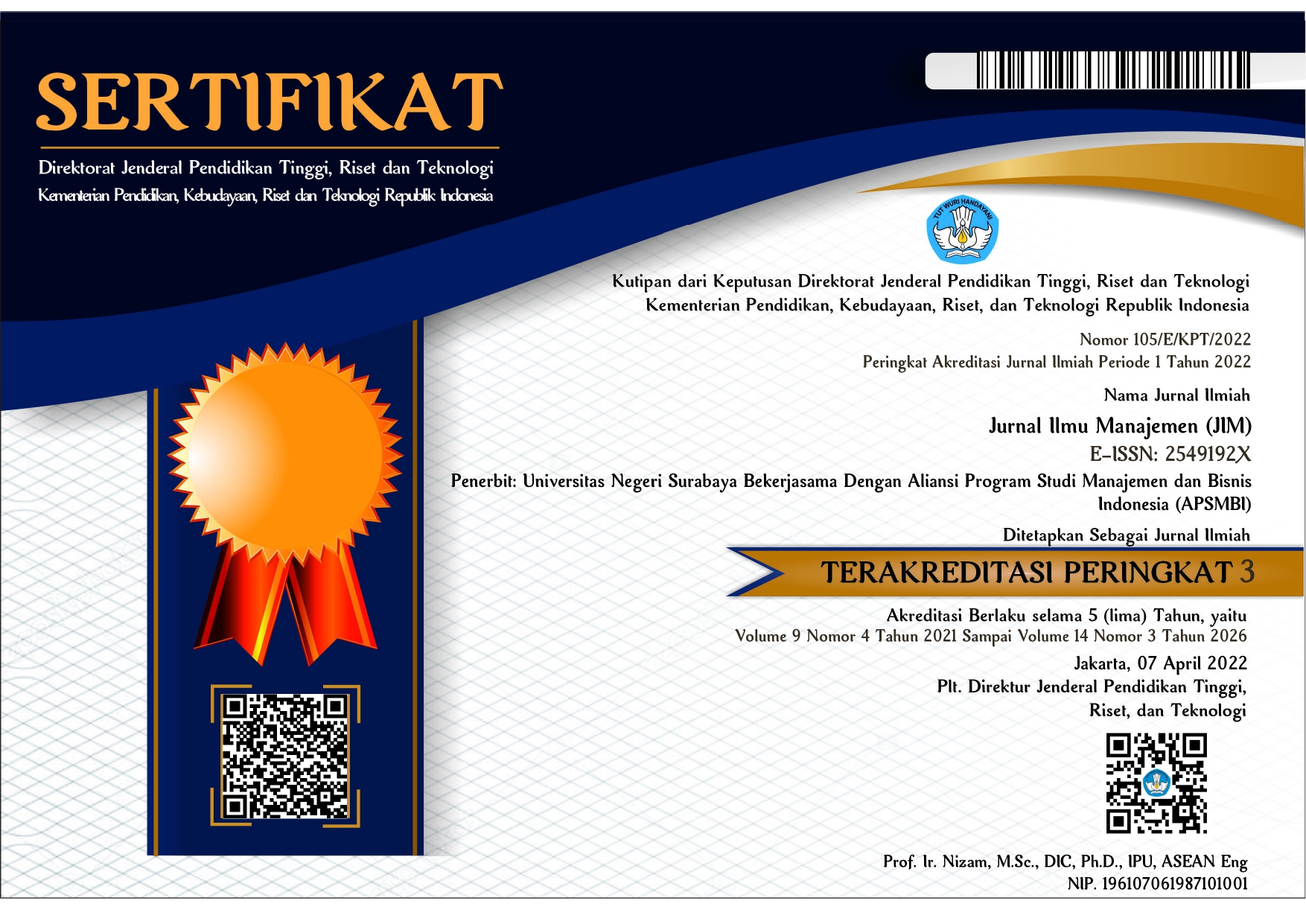City Branding Shining Batu dan E-WOM serta Pengaruhnya terhadap Niat Berkunjung Wisatawan (Studi pada Wisatawan di Kota Batu)
DOI:
https://doi.org/10.26740/jim.v8n3.p748-755Kata Kunci:
City Branding, E-WOM, Shining Batu, Tourist IntentionAbstrak
The purpose of this paper was to study the relationships among city branding, e-WOM (electronic word of mouth), and tourists intention for visiting. The study focused on the tourists who would visit Batu City as the sample by using a nonprobability sampling technique. Questionnaires were distributed to 200 participants by google forms. Data analysis techniques were Multiple Linear Regression with validity and reliability test, classic assumption, and hypothesis test (t-test). The results indicated that city branding is positively influenced by the tourists intention for visiting, but e-WOM is negatively influenced by the tourists intention for visiting. The implications in this study can be used as input for the Batu City Government in developing the city branding œShining Batu to increase tourists intention for visiting.
Referensi
Cahyanti, M. M., & Anjaningrum, W. D. (2018). Meningkatkan Niat Berkunjung Pada Generasi Muda Melalui Citra Destinasi Dan Daya Tarik Kampung Wisata. Jurnal Ilmiah Bisnis Dan Ekonomi Asia, 11(2), 3541. https://doi.org/10.32812/jibeka.v11i2.58
Cai, C., Feng, R., & Breither, D. (2004). Tourist purchase decision involvement and information preferences. Journal of Vacation Marketing, 10(2).
Doosti, S., Jalilvand, M. R., Asadi, A., Khazaei Pool, J., & Mehrani Adl, P. (2016). Analyzing the influence of electronic word of mouth on visit intention: the mediating role of tourists attitude and city image. International Journal of Tourism Cities, 2(2), 137148. https://doi.org/10.1108/IJTC-12-2015-0031
Hasan, A. (2010). Marketing dari Mulut ke Mulut. MEDPRESS.
Hennig-Thurau, T., Gwinner, K. P., Walsh, G., & Gremler, D. D. (2004). Electronic word-of-mouth via consumer-opinion platforms: What motivates consumers to articulate themselves on the Internet? Journal of Interactive Marketing, 18(1), 3852. https://doi.org/10.1002/dir.10073
Horner, S., & John, S. (2007). Consumer Behaviour in Tourism (Second edi).
Humaira, A., & Wibowo, L. A. (2017). Analisis Faktor Elektronik Word of Mouth (Ewom) Dalam Mempengaruhi Keputusan Berkunjung Wisatawan. THE Journal¯: Tourism and Hospitality Essentials Journal, 6(2), 1049. https://doi.org/10.17509/thej.v6i2.5515
Jalilvand, M. R., Ebrahimi, A., & Samiei, N. (2013). Electronic Word of Mouth Effects on Tourists Attitudes Toward Islamic Destinations and Travel Intention: An Empirical Study in Iran. Procedia - Social and Behavioral Sciences, 81(2006), 484489. https://doi.org/10.1016/j.sbspro.2013.06.465
Jalilvand, M. R., & Samiei, N. (2012). The impact of electronic word of mouth on a tourism destination choice: Testing the theory of planned behavior (TPB). Internet Research, 22(5), 591612. https://doi.org/10.1108/10662241211271563
Jannah, B., Arifin, Z., & Kusumawati, A. (2014). Pengaruh City Branding Dan City Image Terhadap Keputusan. Jurnal Administrasi Bisnis (JAB), 17(1), 17.
Juncheng, W. wenying D. (2013). International City Branding Symposium 2013:Positioning Cities: Innovative and Sustainable Strategies for City Development and Transformation. Proceedings of International City Branding Symposium 2013, 506.
Kemenpar.go.id. (2019). Menuju Pembangunan Pariwisata Berkelanjutan. (https://www.kemenpar.go.id/post/menuju-pembangunan-pariwisata-berkelanjutan diakses pada 20 Oktober 2019)
Kotler, P., & Keller, K. L. (2009). Manajemen Pemasaran (Edisi 13). PT Indeks.
Lin, C., Wu, Y.-S., & Chen, J.-C. V. (2013). Electronic Word-of-Mouth: The Moderating Roles of Product Involvement and Brand Image. Proceedings of 2013 International Conference on Technology Innovation and Industrial Management, 2947.
Malhotra, N. K. (2009). Riset Pemasaran Pendekatan Terapan (Edisi Keem). PT Indeks.
Martin, C. ., & Tulgan, B. (2002). Managing The Generational Mix. HRD Press.
Mowen, C. J., & Minor, M. (2002). Perilaku Konsumen (Edisi 5). Erlangga.
Mujihestia, T. I., Troena, E. A., & Hussein, A. S. (2018). the Role of City Image and Visitors Satisfaction on Visitors Revisit Intention: a Study in an Enclave City. Jurnal Aplikasi Manajemen, 16(2), 309320. https://doi.org/10.21776/ub.jam.2018.016.02.14
Ramseook-Munhurrun, P., Seebaluck, V. N., & Naidoo, P. (2015). Examining the Structural Relationships of Destination Image, Perceived Value, Tourist Satisfaction and Loyalty: Case of Mauritius. Procedia - Social and Behavioral Sciences, 175(February), 252259. https://doi.org/10.1016/j.sbspro.2015.01.1198
Pemerintah Indonesia. 2009. Undang-Undang No 10 Tahun 2009 tentang Kepariwisataan. Lembaran Negara Republik Indonesia Tahun 2009 Nomor 11. Menteri Hukum dan Hak Asasi Manusia Republik Indonesia. Jakarta.
ppid.batukota.go.id. (2020). Kunjungan Wisatawan ke Kota Batu Tahun 2018 (https://ppid.batukota.go.id/daftar_informasi/detail/kunjungan-wisatawan-ke-kota-batu_tahun-2018_dinas-pariwisata diakses pada 24 Februari 2020)
Simamora, B. (2005). Analisis Multivariat Pemasaran. Gramedia Pustaka Utama.
Simon, A. (2007). Competitive Identity¯: The new brand management for nations, cities and regions. Palgrave Macmillan.
Sumarwan, U. (2015). Perilaku Konsumen Teori dan Penerapannya (Edisi Keti). PT Ghalia Indonesia.
Suryadana, M. L., & Octavia, V. (2015). Pengantar Pemasaran Pariwisata (Edisi Kesa). Alfabeta.
Ubjaan, J. (2017). Effect of City Branding Toward City Image, Value Perception and Revisit Intention (Study Toward Domestic Tourist in City of Ambon, Indonesia). International Journal of Science and Research (IJSR), 6(9), 460464. https://doi.org/10.21275/ART20176613
Wahab, S. (2001). Manajemen Kepariwisataan. PT Pradnya Paramita.
Wijaya, T., Paramita, L., & Salatiga, J. D. (2014). PENGARUH ELECTRONIC WORD OF MOUTH ( eWOM ) TERHADAP KEPUTUSAN PEMBELIAN KAMERA DSLR. Sancall, 1219.
Yananda, M. R., & Salamah, U. (2014). Branding Tempat¯: Membangun Kota, Kabupaten dan Provinsi Berbasis Identitas. Makna Informasi.
Yoeti A, O. (2008). Perencanaan dan Pengembangan Pariwisata (Edisi Kedu). PT Pradnya Paramita.
Zarrad, H., & Debabi, M. (2015). Analyzing the Effect of Electronic Word of Mouth on Tourists attitude toward Destination and Travel Intention. International Research Journal of Social Sciences, 4(4), 5360. www.isca.in
Zhang, L., & Zhao, S. X. (2009). City branding and the Olympic effect: A case study of Beijing. Cities, 26(5), 245254. https://doi.org/10.1016/j.cities.2009.05.002
Unduhan
File Tambahan
Diterbitkan
Cara Mengutip
Terbitan
Bagian
 Abstract views: 824
,
Abstract views: 824
, PDF Downloads: 652
,
PDF Downloads: 652
, PDF Downloads: 0
PDF Downloads: 0










